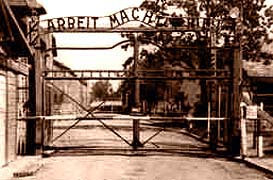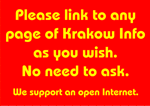|

KL Auschwitz
Death Camp in Oswiecim
Site of the notorious German Nazi Concentration and
Extermination Camp of Auschwitz and Birkenau is located
seventy kilometers west of
Krakow
which make an hour’s drive. Between June 1941 and January 1945
about one million men, women and children perished in the three
Auschwitz concentration camps – i.e. Auschwitz proper, Birkenau
and Monowitz – and their more than forty sub-camps. At its peak
the whole complex of the Auschwitz death camp was a deadly
prison to some 150,000 inmates that were being either murdered
outright or starved and worked to death.
Visiting the Auschwitz and Birkenau
Currently every year some 1,400,000 visitors come to
Oswiecim, an industrial town of 45,000, to see the
Auschwitz. Half of them are Poles, and the rest mostly from
the USA, Germany, the UK, France, Italy, and Israel. Nearly
30 million people have already visited the place.
Please note that exhibitions may prove traumatic
and visiting the death camps isn't appropriate for kids
under 14.
It takes minimum an hour to see the Auschwitz proper, and
another to visit the nearby Birkenau site called Auschwitz II.
They are open to visitors (except January 1, December 25, and
Easter Sunday) from 8 a.m. to 7 p.m. June through August, till 6
p.m. in September, till 5 p.m. in October, till 4 p.m. in
November, till 3 p.m. in December through February, till 4 p.m.
in March, till 5 p.m. in April, till 6 p.m. in May. Archives,
library, collections, management, etc. work on weekdays from 8
a.m. to 2 p.m.
Independent visitors may and groups should employ an authorized
guide. Over 150 of them provide tours in Croatian, Czech,
English, French, German, Hungarian, Italian, Japanese, Polish,
Russian, Serbian, and Spanish.
Admission to the Auschwitz and Birkenau is free. Unfortunately
huge numbers of visitors have prompted the management to
restrict access to Auschwitz proper to guided tours only between
10 a.m. and 3 p.m. from April 1st through October 31st.
Individual tourists may join English tours at 9:30 a.m., 10:30
a.m., 11:30 a.m., half past noon, 1:30 p.m., and 2:30 p.m.,
German tours at 10:30 p.m., noon, and 1:30 p.m., French tours at
10:30 p.m., noon, and 1:30 p.m., Spanish tours at noon and 2
p.m., and Italian tours at 10:30 p.m., noon, and 1:30 p.m. Such
a tour lasts about four hours and it costs 38 zloties per
person.
Booking office is open from 7 a.m. to 3 p.m. on weekdays. Phone
number (+48) 338448100 or 0338448099, fax
(+48) 338432227. Web site www.auschwitz.org.pl
Individual visitors are free to see the Birkenau site (Auschwitz
II) anytime during opening hours. Auschwitz proper and Birkenau
are situated some three kilometers apart, a forty minutes' walk.
A free bus links the two sites from April 15th through October
31st departing every 60 minutes: from Birkenau on the hour and
from Auschwitz 30 minutes later.
Note: individual tourists ought to book their
visit online in advance via the website of the Auschwitz
Museum at http://visit.auschwitz.org
Travel to Auschwitz and Birkenau
Oswiecim is easily accessible owing to the region’s extensive
railroad and bus networks and the ample road system. When in
Krakow, motorists may reach Oswiecim fastest via the paid
four-lane expressway to Katowice (exit to Chrzanów after some 20
minutes).
Every day frequent buses and - less frequent - trains leave for Oswiecim from
Krakow's centrally situated bus depot at 18 Bosacka street and
the main rail station adjoining the Old Town to the northeast.
As to public transport, a bus that stops by the Auschwitz site
seems more convenient than a train.
A number of
travel agencies in Krakow
offer
day trips
to the Auschwitz.
History of the Auschwitz-Birkenau Death Camp
In 1939 Hitler annexed the old Polish town of Oswiecim to his
Third Reich as Auschwitz, and a year later the Nazis could start
the conversion of the town’s abandoned barracks into a
concentration camp called
Konzentrationslager Auschwitz in German. First inmates, a
group of Polish political prisoners, arrived on June 14, 1940.
In addition to Poles there were soon imprisoned Soviet POW’s,
Gypsies, and other nationals from the rest of German-occupied
Europe to suffer and die in hellish conditions. In 1942, notably
after the construction of the nearby Birkenau (Auschwitz II)
concentration camp, trainloads of European Jews start to come.
Most of them were immediately put to death in the Birkenau gas
chambers.
-
October 1939: the Nazis annex the ancient Polish town of
Oswiecim to the Third Reich and rename it Auschwitz.
-
November 1939: new German administration installs a
German mayor.
-
1940-1944: Polish peasants are being driven out of the
area to make room for German settlers.
-
1940: on Himmler’s order Jewish slave workers change
emptied army barracks into a concentration camp.
-
June 14, 1940: the Nazis bring political prisoners, all
of them Poles, to Auschwitz Concentration Camp as its
first inmates.
-
1941: all Jews are forced out of Oswiecim.
-
October 1941: construction of the Birkenau Concentration
Camp, i.e. Auschwitz II, starts near Oswiecim.
-
1942: setting up of Auschwitz III-Monowitz Concentration
Camp.
-
January 1945: evacuation of the Auschwitz camps.
-
January 27, 1945: the Soviets take over Oswiecim.
-
1947: new Polish government creates Auschwitz-Birkenau
State Museum on the site of the concentration camps.
-
1967: erecting of the International Monument to the
Victims of Fascism at Birkenau.
-
1979: UNESCO enters the Auschwitz concentration camp and
the Birkenau death camp in its list of World Heritage
sites.
-
1986: launching of the Youth Meeting House in Oswiecim.
-
1992: opening of the Center Dialogue and Prayer.
-
2000: opening of the Auschwitz Jewish Center and Chevra
Lomdei Mishnayot Synagogue.
Other UNESCO World Heritage sites in Krakow and the Malopolska
Province
Krakow's Old Town historic district
Wieliczka salt mine
The Calvary sanctuary of Kalwaria Zebrzydowska
Malopolska's wooden churches
Selected
Krakow operators providing tours and day trips.
Any following information has been provided by respective
organizations on their sole responsibility.
|
In the proximity of Krakow
Krakow is Poland's tourist mecca, and also a gateway to
many other must-see sites in the region.
Jewish Ghetto in Krakow
KL Plaszow concentration camp in Krakow
See trains
from Krakow to Oswiecim
and from Oswiecim to Krakow.
Malopolska
Province
Poland map
City of Krakow map
Krakow
Poland's prime tourist attraction and a must in Central
Europe boasts numerous world-class monuments, charming vistas,
delightful atmosphere, and the best restaurants.
Hotels in Krakow
Hostels in Krakow
Restaurants in Krakow
|



